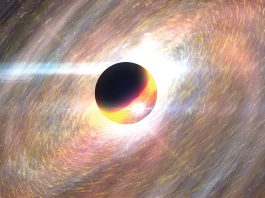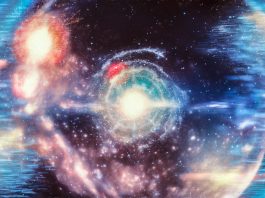Scientists have made a revolutionary breakthrough surrounding the particle interactions that take place in the core of a neutron star.
Using new results from precision particle detectors at the Relativistic Heavy Ion Collider (RHIC) scientists have made groundbreaking discoveries, giving nuclear physicists a new way to search for violations of fundamental symmetries in the universe.
The new measurements taken by the research group exposed the binding energy which holds together the components of the simplest ‘strange-matter’ nucleus, known as a ‘hypertriton’.
For the second measurement, scientists searched for a difference between the mass of the hypertriton and its antimatter counterpart, the antihypertriton. This discover would prove “CPT” violation, a simultaneous violation of three fundamental symmetries in nature pertaining to the reversal of charge, mirror symmetry, and time.
“Physicists have seen parity violation, and violation of CP together but never CPT,” said Brookhaven physicist Zhangbu Xu, co-spokesperson of RHIC’s STAR experiment, where the hypertriton research was conducted. According to Xu, no one has looked for CPT violation in the hypertriton and antihypertriton, “because no one else could yet.”
Scientists have previously conducted CPT tests of the heaviest nucleus. This was performed by the ALICE collaboration at Europe’s Large Hadron Collider (LHC), where they measured the mass differences between ordinary helium-3 and antihelium-3. Published in 2015, the results showed no significant difference.
Detector components added to STAR tracked different kinds of particles, simplifying the search. These components, called the ‘Heavy-Flavor Tracker’, are located very close to the STAR detector’s centre. These inner components allow scientists to match up tracks created by decay products of each hypertriton and antihypertriton with their point of origin just outside the collision zone.
The search for daughter particles
“What we look for are the ‘daughter’ particles—the decay products that strike detector components at the outer edges of STAR,” said Berkeley Lab physicist Xin Dong.
Locating pairs or triplets of daughter particles that originate from a single point just outside the primary collision zone allows scientists to pick these signals out of other particles streaming from each RHIC collision.
“Then we calculate the momentum of each daughter particle from one decay (based on how much they bend in STAR’s magnetic field), and from that we can reconstruct their masses and the mass of the parent hypertriton or antihypertriton particle before it decayed,” explained Declan Keane of Kent State University (KSU).
“Keane’s team, including Irakli Chakeberia, has specialized in tracking these particles through the detectors to ‘connect the dots,’” Xu said. “They also provided much needed visualisation of the events.”
The STAR physicists derived the binding energy by subtracting their value for the hypertriton mass from the combined known masses of a deuteron (a bound state of a proton and a neutron) and one lambda.
“The hypertriton weighs less than the sum of its parts because some of that mass is converted into the energy that is binding the three nucleons together…This binding energy is really a measure of the strength of these interactions, so our new measurement could have important implications for understanding the ‘equation of state’ of neutron stars,” said Fudan University STAR collaborator Jinhui Chen, whose PhD student.
“There’s great interest in understanding how these interactions—a form of the strong force—are different between ordinary nucleons and strange nucleons containing up, down, and strange quarks,” Chen continued. “Because these hypernuclei contain a single lambda, this is one of the best ways to make comparisons with theoretical predictions. It reduces the problem to its simplest form.”









